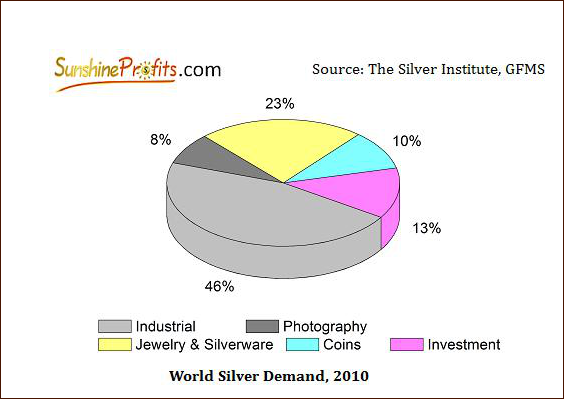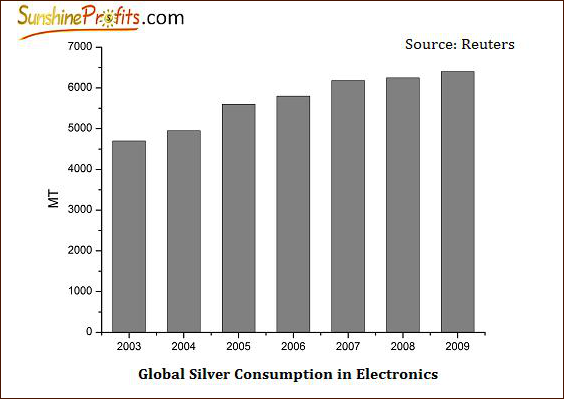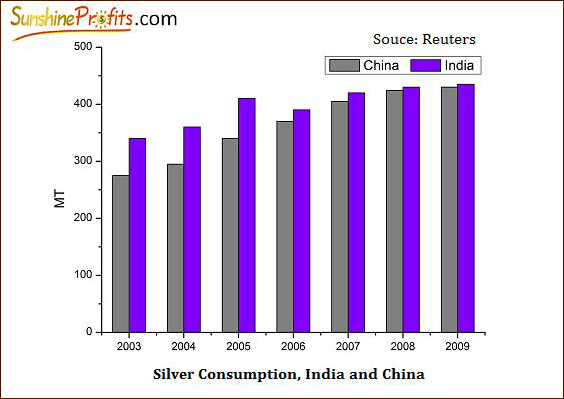The full version of our analysis (with comments particularly valuable for Precious Metals Traders) is available to our Subscribers. Visit our archives for more silver articles.
Irrespective of the concerns over financial tightening, talks of a gold bubble and economical weakness, gold marked its tenth straight annual gain in 2010. Not only gold, other members of the precious metal group such as silver and platinum were also up last year. At this juncture, last years bull run appears to be running out of steam. However, both technicals and fundamentals indicate improved investment options in precious metals, particularly silver, if you have a long-term investment horizon.
The role of market fundamentals in determining market direction is significant in all markets, and precious metals market is no exception. Since a strong relationship between economic indicators and precious metal market exists (evident from correlation analysis), positives in the economical aspects would definitely reflect in market moves. From a fundamental point of view, economic growth is expected to boost demand from end-user segments. Let us have a look at physical demand for silver and its impacts on the market.
Silver is mostly used as components in highly sophisticated areas of technology or jewelry. Reliability and performance are the primary reasons why precious metals are used in electronic devices. As the electronics sector has been inching towards increased sophistication in the past few years, silver demand has been on the rise. The growth of the electronics industry in the BRIC nations is also encouraging for silver demand. Big markets with relatively lower penetration levels (and hence potential growth areas), such as India and China, are certainly the talking point in most investment articles making a case for silver.
Electronics and Electricals; Plus Growing Demand from New Uses
Global silver demand, buoyed by higher industrial applications and strong investor interest, has recovered well from the 2008-2009 levels. Electronics is still one of the largest components of silver demand, accounting for more than 60% of the total industrial demand. The stronghold demand source of silver has been doing well over the past few years. Prior to the recession, the global market for electronic products was growing at an healthy annual average of about 13%, from USD 1.4 trillion in 2004 to an estimated USD 2.5 trillion in 2009. With the electronics and electrical industry reverting to a state of normalcy now, the future appears bright and shining. By 2012, the market is expected to reach approximately USD 3.2 trillion.

In addition to the growth in mature industrial bastions such as the electrical and electronic industry, silver demand has grown by leaps and bounds in new areas such as conductive silver inks and new applications in the field of nanotechnology. If silver demand was to be the only factor driving prices, one could close his eyes and simply go long silver for long term. Demand prospects are robust and incisive few other commodities are finding new uses as much as silver has over the recent past.
Increasing quality concerns ensure high use of silver in even ordinary switches and circuit-breakers. On its attribute of being the best conducting metal, silver is used in most electrical appliances such as conductors, switches, contacts and fuses. Silver membrane switches are extensively used in computer keyboards and control panels of electrical and electronic gadgets and appliances. Silver is everywhere in electronic appliances enough to impart a considerable impetus to global consumption (which shows a steady rise despite the recession).

Talking of alternative uses of silver, it is also employed in the production of chemicals for the USD 300 billion global plastics industry. Well over 700 MT (metric tons) of silver every year is required for the production of plastics. As a catalyst, silver is used in the production of ethylene oxide (required for the production of synthetic textiles). Silver demand in industrial applications is diverse and is set to improve with the influx of new technologies. The diversity of demand sources also make it shock-proof i.e. even if one leg of demand weakens the surge in others make up for the weakness.
Other lesser known applications of silver include batteries, catalysts, and brazing and soldering alloys. Emergence of structural changes in the technological front such as silver-zinc batteries, solar (photovoltaic) batteries, RFID smart tags and antibacterial applications could result in substantial consumption of the metal.
There are two major takeaways from the enumeration of silvers industrial demand sources. One - that it is diverse and one should be keeping an eye on a number of industries to comprehend the state of silver fundamentals. Two, unlike other precious metals, silvers dependence on the industry is significantly higher. Notably, during the past decade silver use in industrial applications has increased from 35% of the total silver supply to more than 50% - and it is growing. In other words, the influence that the general stock market has on the white metal is not going to go away in the foreseeable future.
China and India Emerging Electronics and Electricals Markets
Historically, the electronics industry has drawn its strength from the U.S. and Japan; however, in the past few years, other regions, especially China and India, have been rapidly expanding their electronics manufacturing and consumer bases. The phenomenal growth of the electronics industry in the BRIC nations reflects the potential for increasing demand for silver in the upcoming years.
The massive industrial demand from China was clearly evident during this New Year season also; many times during the period, silver traded at a high premium in China over international market prices. What makes the Oriental economies key players in the silver market is not only an expanding electronics market but also a burgeoning jewelry demand. India and China, typically during the Diwali festival and the Chinese New Year respectively, present a massive demand for the white metal. Rapidly growing gold prices has made silver a replacement for gold in jewelry- that has attracted a significant proportion of the middle class population into the silver market in these regions.

Chinas silver market has emerged as a key determinant of international prices because of its significant influence on production and consumption. Since 2000, the Chinese silver industry has been growing both in terms of production and consumption, rewriting records every year. With massive investments in the heavy industry, Chinese consumption of silver alloy, soldering and silver paste has soared in the recent years.
India too is a key participant in the global silver market now. India is the largest importer of silver in the world with a consumption of nearly 4000 tons of silver annually, of which more than 60% is used as jewellery. In terms of industrial use, India ranks third, following the US and Japan. In India, silver fabrication in industrial applications such as electronics and metallurgy accounts for a meagre 15% only. That speaks volumes for the scope of expansion for silver demand from industry.
Although speculative trading is critical in determining prices of most precious metals, a gradual return of fundamentals in driving prices is evident. This is truer for silver, given its strong relationship with the industry.
Summing up, silver, which derives its demand from both industrial and investment use, opens up various investment options at this juncture. With strong fundamentals for the medium- to long-term, silver is expected to perform strongly in the next few years.
To keep yourself informed about the nitty gritties of the precious metals market, I recommend you to sign up for the free e-mail list from Sunshine Profits. Sign up today for our mailing list dedicated to gold & silver investors today and you'll also get free, 7-day access to the Premium Sections on my website, including valuable tools and charts dedicated to serious PM Investors and Speculators. It's free and you may unsubscribe at any time.
Thank you for reading.
Mike Stall
Sunshine Profits Contributing Author
--
Two reports were released last week that are bullish for gold. The World Gold Councils Demand Trends report says gold demand wills stay high this year and that China is breathing down Indians neck to claim the title as the worlds largest consumer of the yellow metal. The U.S. Securities and Exchange Commission revealed the holdings of some of Americas largest hedge funds. The good news is that they still like gold. And another story this weekthe gold rush is onCalifornia here we come!
Silver is up over 6% for the week and Subscribers who followed our analysis took full advantage of this rally - with both long- and short-term capital. However, the recent rally took place on strong volume, which caused the volume for the SLV:GLD ratio to spike - in the past declines followed after such a development. In today's update, we explain if this time is really different. Meanwhile, gold and mining stocks reached resistance levels, so the question is should you exit your speculative positions. Naturally, this is one of the things what we comment on in this week's update.
The ironic fact this week is that part of a bearish head-and-shoulder's pattern in mining stocks appears to be a bullish reverse head-and-shoulders pattern with noteworthy target for the sector. In addition to explaining this phenomenon, we decided - as requested - to provide you with the True (!) Seasonal pattern for gold in March.
We encourage you to Subscribe to the Premium Service today and read the full version of this week's analysis right away.

